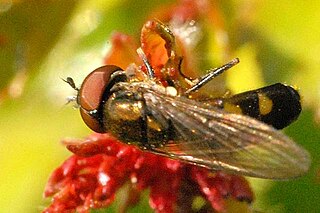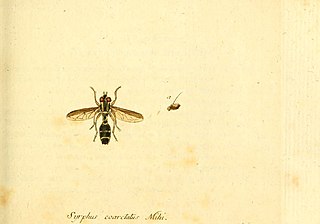
Hoverflies, also called flower flies or syrphids, make up the insect family Syrphidae. As their common name suggests, they are often seen hovering or nectaring at flowers; the adults of many species feed mainly on nectar and pollen, while the larvae (maggots) eat a wide range of foods. In some species, the larvae are saprotrophs, eating decaying plant and animal matter in the soil or in ponds and streams. In other species, the larvae are insectivores and prey on aphids, thrips, and other plant-sucking insects.

Episyrphus balteatus, sometimes called the marmalade hoverfly, is a relatively small hoverfly (9–12 mm) of the Syrphidae family, widespread throughout the Palaearctic region, which covers Europe, North Asia, and North Africa. It is considered the most abundant native hoverfly in Central Europe.

Eristalinae are one of the four subfamilies of the fly family Syrphidae, or hoverflies. A well-known species included in this subfamily is the dronefly, Eristalis tenax.

Xylota segnis, The Brown-toed Forest Fly, is a common species of hoverfly.

Chrysotoxum bicinctum is a species of hoverfly.

Chrysotoxum cautum is a species of hoverfly. It is found in southern Britain and Europe East into the Palearctic but is normally encountered in small numbers. The larvae are thought to feed on root aphids. Adults are usually found on the edges of woodland or scrub or along hedgerows where they visit a wide range of flowers.

Myathropa florea, sometimes referred to as the Batman hoverfly, is a very common European and North African species of hoverfly. Adults may be seen on flowers from May to September. It is of a similar size to the common drone fly, but Myathropa are generally more yellow, with two light bands to the thorax, interrupted with a black central smudge. In museum specimens, any yellow colour soon fades to brown after death. Like most species in the tribe Eristalini, Myathropa are rather variable in size, shape and colour.

Platycheirus clypeatus is a species of hoverfly. It is found across the Palearctic and in the Nearctic. The larvae feed on aphids. Adults are usually found on the edges of woodland or scrub, heath or along hedgerows where they visit a wide range of flowers.

Eupeodes luniger is a common species of hoverfly.

Sphegina montana is a species of hoverfly from Central and Northern Europe. It is absent from Great Britain and Ireland. The face is normally all black; body length is 5–6 mm.

Merodon equestris is a Holarctic species of hoverfly. Like many other hoverflies it displays a colouration pattern similar to a stinging insect as an evolutionary defense mechanism. Other syrphid bee mimics are Mallota, Arctophila, Criorhina, Pocota and Brachypalpus. Merodon species are distinguished from these by the very strong hind femora, which bear a large triangular projection on the underside near the tip. It flies in low vegetation while the other bumblebee mimics prefer higher vegetation layers.

Baccha elongata is a species of hoverfly in the genus Baccha.

Platycheirus manicatus is a species of hoverfly. It is found across the Palearctic and in Alaska.

Platycheirus splendidus is a species of hoverfly. It is found in many parts of Britain and Europe.

Criorhina floccosa, is a species of hoverfly. It is found in many parts of the Palearctic including Europe.

Anasimyia lineata is a Palaearctic species of hoverfly.

Platycheirus ambiguus is a small widespread species of hoverfly found across the Palearctic from Ireland to Japan. A spring species found in flight in April and May, it visits spring-flowering trees and shrubs; e.g., Prunus spinosa in deciduous woodland and scrub.

Doros profuges is a Palearctic species of hoverfly.

Eumerus funeralis or lesser bulb fly is a species of Hoverfly, from the family Syrphidae, in the order Diptera. E. funeralis appears in Peck (1988) as a synonym of E. strigatus (Fallen), but was reinstated as the correct name for tuberculatus Rondani, sensu auctorum by Speight et al. (1998).

Cheilosia psilophthalma is a Palearctic hoverfly closely related and very similar to Cheilosia latigenis, Cheilosia mutabilis and Cheilosia urbana . It is a rare and little known species recorded from Scandinavia, Ireland, Britain, France, Poland, Switzerland, Greece, Montenegro, Serbia, Ukraine and European Russia. Flowers visited include Acer platanoides, Anemone nemorosa, Primula veris, Prunus spinosa and Salix spp. Cheilosia psilophthalma flies in April and May. Open, grassy areas within sparse woodland and unimproved, montane subalpine grassland are preferred habitats. Larvae are recorded as developing in Hieracium pilosella and Hieracium caespitosum.



















